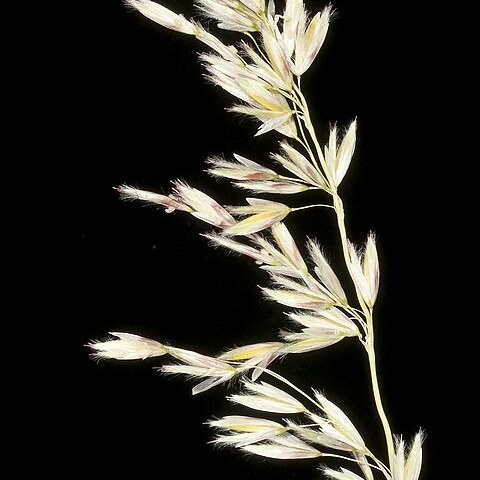Perennials, with a contracted or long rhizome, erect. Culms to 120 cm high; mid-culm internodes glabrous. Leaves non-auriculate; ligule 1–2 mm long, usually fringed or unfringed; blade involute, 5–20 cm long, 4–8 mm wide, abaxially puberulous. Inflorescences paniculate or a single raceme, 13–25 cm long. Spikelets 9–14 mm long. Glumes equal to subequal, slightly shorter than remainder of spikelet; lower glume 8.4–11 mm long, weakly keeled, (5–) 7–9-nerved; upper glume 9–12.5 mm long, acute, 7–9-nerved. Sterile florets: lemmas not stipitate, without basal appendages, acute to obtuse, muticous to awned, with awn much shorter than body of lemma, smooth, densely villous with long silky hairs, with tuft of hairs immediately above base on keel; lower lemma with 2 tufts of hairs on margins at base; upper lemma 10–13.5 mm long. Bisexual floret: lemma 8.5–11 mm long; 7 (–9)-nerved, villous; stamens 6.
Tufted robust, erect perennial, up to 1.5 m high; long naked rhizomes; culm up to 5 mm wide. Leaf blade up to 15-130 x 8 mm, rolled, often deciduous; ligule a fringe of hairs to a fringed membrane. Inflorescence a panicle, subtended by an inflated leaf sheath or exserted from uppermost leaf sheath. Spikelet up to 10-18 x 4 mm; glumes almost equal, 3/4 to as long as spikelet, 5-nerved. Florets 3; lower 2 florets sterile, awned, lemmas similar, profusely hairy, second sterile lemma without an ear-like appendage at base; uppermost floret bisexual, lemma firmer than glumes; anther 5.0-8.9 mm long. Flowering time Sept.-Mar. (sporadically.
Spreading perennial, up to 1.5 m tall, rhizomes elongate, with naked internodes, culms branched. Leaf blades flat; ligule a fringed membrane to a fringe of hairs. Inflorescence a raceme-like, verticillate panicle. Spikelets 10-18 mm long, green or straw-coloured, sometimes tinged with purple, glumes shorter than to as long as spikelet, sterile lemmas smooth, villous, truncate to aristate.
Perennial to 1.5 m, with well-developed, naked rhizomes with elongate internodes. Leaves linear, fairly short-lived, margins undulate. Spikelets in contracted or verticillate panicle, straw-coloured, glumes to as long as spikelet, sterile lemmas villous, truncate to mucronate.

